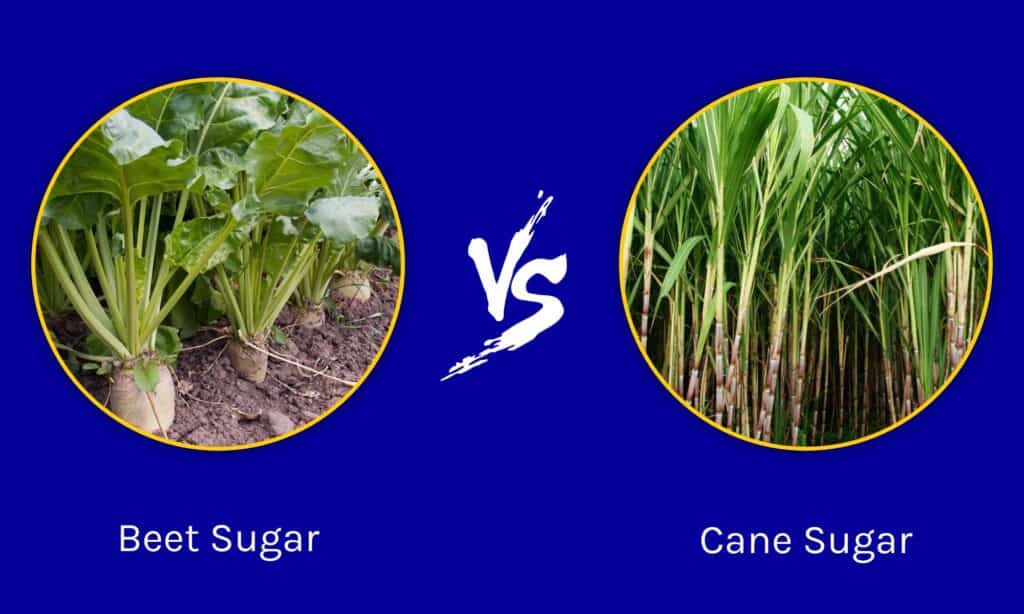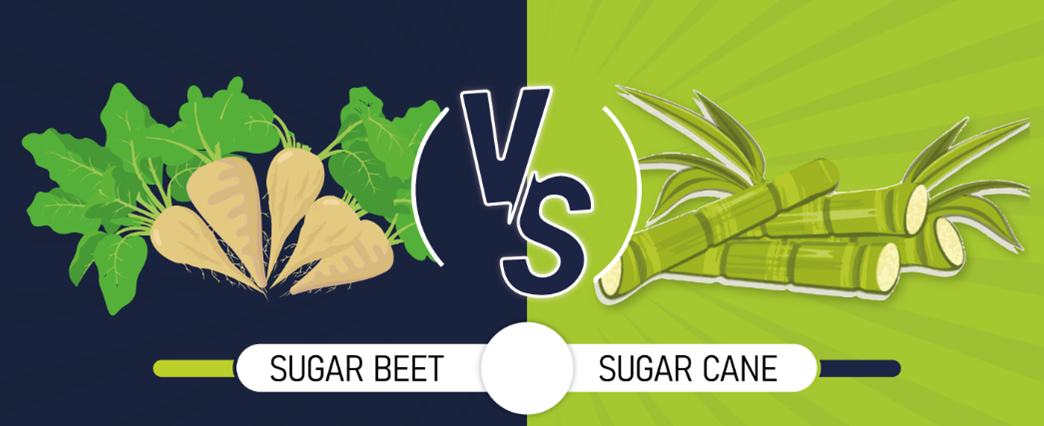Unpacking Sugar Beet Vs Sugar Cane: Vital Info on Their Uses and Influence on the Sugar Market
The distinction in between sugar beet and sugar cane plays a necessary function in the worldwide sugar market. Each crop has distinct farming practices and geographic preferences. Their handling approaches vary considerably, impacting nutritional accounts and financial effects. Moreover, environmental sustainability is becoming progressively relevant in customer selections. Understanding these aspects can illuminate the intricacies of the sugar industry and its future instructions. What remains to be checked out are the changing patterns that can reshape this landscape.
Summary of Sugar Beet and Sugar Cane
Sugar beet and sugar cane are 2 primary sources of sucrose, each grown in distinct atmospheres and possessing special characteristics. Sugar beet, an origin vegetable, thrives in pleasant climates, mostly in Europe and North America. It is normally harvested in the loss and goes through processing to essence sugar from its high sucrose web content. In comparison, sugar cane is an exotic yard that grows in warmer regions, such as Brazil and India. Its high stalks are gathered year-round, offering a constant supply of sugar.The sucrose drawn out from sugar cane is usually perceived as having a much more complicated taste account compared to that from sugar beet. Both sources contribute significantly to the international sugar market, affecting prices and availability. Recognizing their distinctions is essential for stakeholders in farming, food manufacturing, and business economics, as these crops play an essential duty in food systems worldwide.
Cultivation Practices and Geographic Circulation
Both sugar beet and sugar cane are important sources of sucrose, their growing methods and geographical distribution differ considerably. Sugar beet thrives in pleasant climates, especially in Europe and North America, where its cooler expanding periods boost origin growth. Farmers commonly exercise plant rotation and make use of advanced agricultural technologies to maximize yields, favoring well-drained, fertile soils.In contrast, sugar cane embellishments in tropical and subtropical regions, with Brazil, India, and China being the leading manufacturers. Its farming needs warmer temperatures and enough rains, making irrigation crucial in drier locations. Sugar cane is commonly expanded in monoculture systems, which can bring about dirt exhaustion if not handled sustainably. Additionally, collecting techniques vary; sugar cane is usually reduced by hand or equipment, while sugar beet is generally gathered making use of customized devices. These geographic and cultivation variations substantially influence the international sugar market and local economic climates.
Processing Methods and Production Methods
The processing methods and manufacturing techniques for sugar beet and sugar cane emphasize significant distinctions that influence the final product's top quality and characteristics. Sugar beetroots undertake a straightforward procedure, where they are gathered, washed, and sliced into thin chips prior to being subjected to hot water removal to dissolve the sugar. The resulting juice is then clarified, vaporized, and crystallized to produce granulated sugar.Conversely, sugar cane handling involves squashing the stalks to draw out juice, complied with by a collection of home heating and boiling steps. This technique consists of the elimination of pollutants and further dissipation, resulting in crystallization. Furthermore, sugar cane processing usually highlights the production of molasses and bagasse, which can be made use of for energy or various other products.These varied techniques show not just the differences in the source materials yet likewise their ramifications for effectiveness, sustainability, and final sugar attributes out there.
Nutritional Profiles and Health And Wellness Implications
An analysis of the nutritional profiles of sugar beet and sugar cane reveals distinctive distinctions in their nutrient structure. Each source uses unique wellness advantages that can influence nutritional selections. Understanding these variants is important for making informed decisions concerning sugar intake and total health.

Nutrient Make-up Contrast
Nutritional profiles of sugar beet and sugar cane expose distinctive distinctions that can affect wellness end results. Sugar beetroots consist of greater levels of important nutrients such as fiber, potassium, and magnesium, which contribute to gastrointestinal health and cardiovascular function. On the other hand, sugar cane mainly supplies sucrose, with minimal nutritional worth past energy provision. The fiber content in sugar beets aids in managing blood sugar level degrees, while sugar cane lacks this advantage. In addition, sugar beets have a lower glycemic index compared to sugar cane, which might be advantageous for people taking care of blood sugar level. These variations in nutrient composition underscore the importance of considering the source of sugar, especially for those mindful of their dietary options and total health.
Wellness Conveniences Overview
Health benefits originated from sugar beet and sugar cane consumption vary considerably due to their differing dietary accounts. Sugar beets are rich in vital nutrients, including dietary fiber, vitamins, and minerals, particularly folate and potassium. This composition can support gastrointestinal wellness, boost cardiovascular function, and help in blood glucose regulation. In comparison, sugar cane mostly uses a source of carbs and energy, with fewer nutrients. Nevertheless, it includes anti-oxidants, which might assist deal with oxidative tension and inflammation. Sugar beet vs sugar cane. The wellness ramifications of consuming these sugars additionally rely on their forms-- entire foods find versus fine-tuned sugars-- impacting total benefits. Eventually, small amounts is crucial, as extreme consumption of either can cause health and wellness issues, emphasizing the relevance of balanced intake
Financial Influence on Regional and International Markets
Both sugar beet and sugar cane serve as important sources of sugar, their economic influences on local and worldwide markets vary significantly. Sugar cane mainly grows in tropical environments, making it a staple in countries like Brazil and India, where the agricultural facilities is heavily geared towards massive vineyards. This adds to significant export revenues and job opportunity in these areas. Alternatively, sugar beet is frequently cultivated in warm areas, particularly in Europe and North America, where its manufacturing sustains regional economic climates through smaller-scale farming and handling industries.The international sugar market is influenced by tariffs, profession arrangements, and aids, which can prefer one sort of sugar over the various other. Variations in rates additionally affect both regional farmers and global markets, leading to varying economic stability in regions dependent on sugar manufacturing. The economic landscape formed by sugar beet and sugar cane is complex and multifaceted, reflecting wider agricultural trends.

Environmental Factors To Consider and Sustainability
The environmental considerations bordering sugar beet and sugar cane manufacturing emphasize substantial distinctions in land use, water consumption, and carbon footprints. Comprehending these elements is essential for examining the sustainability of each crop. The influences of cultivation techniques on ecosystems and sources have to be thoroughly analyzed to inform future farming decisions.
Land Use Impacts
When examining the land usage influences of sugar beet and sugar cane cultivation, it ends up being apparent that each plant presents distinctive ecological considerations and sustainability obstacles. Sugar beet, typically expanded in warm areas, commonly needs considerable land conversion in locations previously utilized for diverse crops, potentially bring about decreased biodiversity. In contrast, sugar cane is primarily grown in exotic areas, where its considerable land demands can bring about deforestation and habitat loss. Additionally, sugar cane fields may displace food plants, increasing issues concerning food safety and security. Both crops contribute to soil degradation with monoculture techniques, necessitating sustainable farming approaches. Inevitably, the land usage implications of both sugar beet and sugar cane growing highlight the need for balance in between economic stability and ecological stewardship.
Water Consumption Differences
Water consumption represents an important consider examining the sustainability of sugar beet and sugar cane manufacturing. Sugar cane typically needs substantially much more water than sugar beet, mostly due to its growth conditions in exotic atmospheres where watering is frequently needed. On the other hand, sugar beet is mostly grown in pleasant areas and typically depends a lot more on rains, making Clicking Here it much less depending on substantial watering systems. This distinction in water use impacts regional water resources and can result in worries over water deficiency. The effectiveness of water usage in sugar beet growing usually results in reduced general water footprints contrasted to sugar cane. Comprehending these my site variations is necessary for reviewing the environmental implications and sustainability of these two sugar sources.
Carbon Impact Evaluation
Examining the carbon footprint of sugar beet and sugar cane production is necessary for comprehending their general ecological influence. Sugar beet farming usually leads to a lower carbon footprint contrasted to sugar cane, greatly because of the decreased reliance on nonrenewable fuel sources for handling and transportation. Furthermore, sugar beet is usually expanded in warm climates, decreasing the need for comprehensive watering and minimizing greenhouse gas exhausts. In contrast, sugar cane farming typically includes higher energy intake, especially in exotic regions, where growing and processing can be resource-intensive. Additionally, land-use changes related to sugar cane expansion can aggravate carbon emissions. Eventually, both plants present unique sustainability difficulties that must be resolved to minimize their environmental impact in the global sugar market.
Future Trends in the Sugar Market
Just how will the sugar industry evolve in the coming years? Industry specialists forecast several transformative patterns forming its future. A substantial shift towards sustainability is prepared for, driven by heightened consumer recognition and regulatory stress. This will likely bring about enhanced investments in eco-friendly manufacturing methods, benefiting both sugar beet and sugar cane growers.Additionally, technical advancements, such as precision agriculture and biotechnology, are expected to boost plant yields and decrease source intake. The sector may also see an increase in different sugar, as customers increasingly seek much healthier options.Moreover, the international demand for sugar is projected to rise and fall, influenced by changing dietary preferences and economic conditions. As countries carry out more stringent sugar tax obligations, suppliers will certainly require to adapt their techniques to stay competitive. Generally, the sugar market appears positioned for substantial advancement, stressing sustainability and innovation in reaction to market dynamics.
Often Asked Questions
What Are the Main Differences in Preference In Between Sugar Beet and Sugar Cane?
The major distinctions in preference between sugar beet and sugar cane can be refined. Sugar cane is usually explained as having a richer, a lot more intricate taste, while sugar beet tends to be rather milder and less aromatic.
How Do Sugar Beet and Sugar Cane Affect Cooking Recipes Differently?
The distinctions in between sugar beet and sugar cane in cooking recipes mostly hinge on their moisture content and taste profiles - Sugar beet vs sugar cane. Sugar cane frequently boosts caramelization, while sugar beet has a tendency to yield an extra neutral sweetness
Can Sugar Beet and Sugar Cane Be Made Use Of Reciprocally in Cooking?
Sugar beet and sugar cane can usually be used mutually in cooking; nonetheless, subtle distinctions in flavor and structure may influence the last outcome of dishes, relying on the particular dish and desired outcomes.

What Are the Spin-offs of Processing Sugar Beet and Sugar Cane?
The byproducts of processing sugar beet consist of molasses, pet feed, and biofuels, while sugar cane processing returns bagasse, molasses, and ethanol (Sugar beet vs sugar cane). Both plants contribute considerably to different markets beyond sugar manufacturing
Just How Do Sugar Beet and Sugar Cane Contribute to Biofuel Production?
Sugar beet and sugar cane serve as substantial sources for biofuel manufacturing. Their residues, after sugar removal, can be transformed right into bioethanol, adding to renewable resource campaigns and minimizing reliance on fossil gas in different areas.